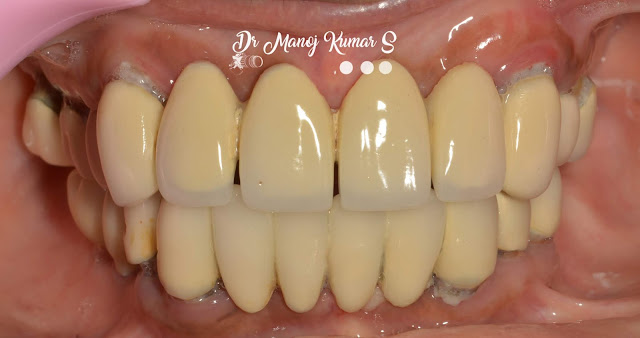dental fluorosis.


DENTAL FLUOROSIS:
A condition of emamel hypoplasia characterized by white chalky spots or brown staining and pitting of teeth due to an increased level of fluoride affecting enamel matrix formation and calcification by impairment of ameloblastic function.
CLINICAL FEATURES:
1. yellow to brown pigmentation
2.varing degrees of pitting and mottling
3.bilaterral symmetric distribution
4.varying levels of severity
5.a permanent disfigurement
6severe mottling may result in excessive wear and fracturing of the incisal and occlusal surfaces due to soft enamel.
Differential Diagnosis:
1.dental fluorosis
2.focal enamel hypoplasia
3.enamel hypoplasia from congenital syphilis
4.contemporaneous hypoplasia
5.hypoplasia due to vitamin D deficiency
6.incipient caries
7.amelogenesis imperfecta
Classification Criteria for Mild Dental Fluorosis - Dean's Fluorosis Index
Score Criteria :
Normal:
The enamel represents the usual translucent semivitriform type of structure. The surface is smooth, glossy, and usually of a pale creamy white color.
Very Mild:
Small opaque, paper white areas scattered irregularly over the tooth but not involving as much as 25% of the tooth surface. Frequently included in this classification are teeth showing no more than about 1-2 mm of white opacity at the tip of the summit of the cusps of the bicuspids or second molars.
Mild:
The white opaque areas in the enamel of the teeth are more extensive but do not involve as much as 50% of the tooth
Moderate:
All enamel surfaces of the teeth are affected, and the surfaces subject to attrition show wear. Brown stain is frequently a disfiguring feature.
Severe:
Includes teeth formerly classified as "moderately severe and severe." All enamel surfaces are affected and hypoplasia is so marked that the general form of the tooth may be affected. The major diagnostic sign of this classification is discrete or confluent pitting. Brown stains are widespread and teeth often present a corroded-like appearance
Treatment:
cosmetic veneers, professional bleaching or micro-abrasive treatment
WHAT IS TEETH BLEACHING ?
Teeth bleaching on a simple scale is the treatment of teeth using an oxidising or bleaching agent to lessen or eliminate stains by lightening the discoloration of the enamel or dentin of our teeth. Causes of teeth discoloration can be due to aging, consumption of staining substances such as coffee or tea, smoking, trauma and nerve degeneration. Other than self-treatment by using commercial products, professional dental treatment is strongly encouraged.
Professional Treatment:
1. Before treatment, the dentist will examine the patient orally and ensure that the patient has a set of healthy and unrestored teeth before deciding whether the patient is a suitable candidate for teeth bleaching.
2. There are two main ways to bleach teeth:
Procedure A:
• The dentist first takes an impression of the upper and lower row of teeth.
• Plaster models are made from these moulds and then trays to cover the teeth are made from the models.
• A small solution of bleaching solution is placed in the trays to be worn over the teeth.
The trays must be able to prevent the solution from concentrating over the gum, as the bleaching solution, when allowed to remain in contact on the gum for too long, will cause the gum to irritate or burn.
• The trays are worn over the teeth for a period of 11/2-2 hours daily for 3-6 weeks, with visits to the dentist scheduled every 2 weeks.
Procedure B— a more popular method
• It requires only one appointment.
• A safe bleaching solution is applied to the teeth and exposed to a small intense light that activates the bleach.
• After the above steps are repeated 2-3 times, the teeth are then polished.
• Procedure only requires 40 minutes.


Comments